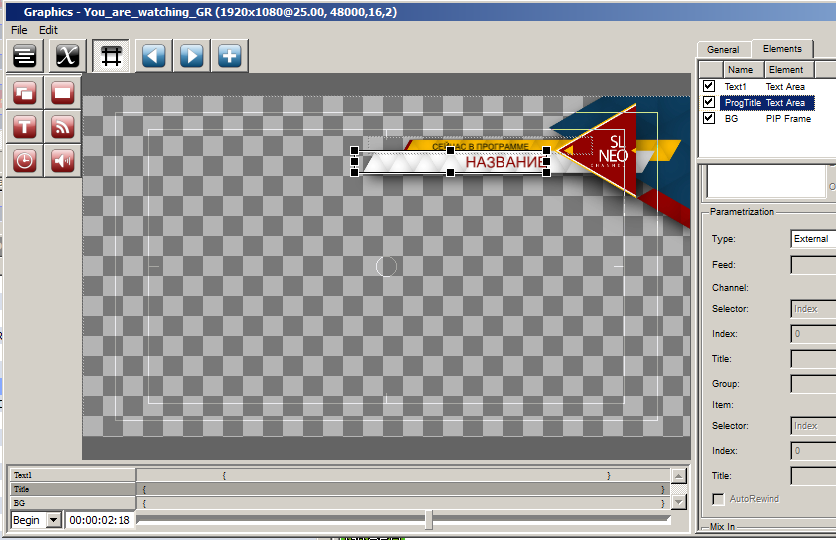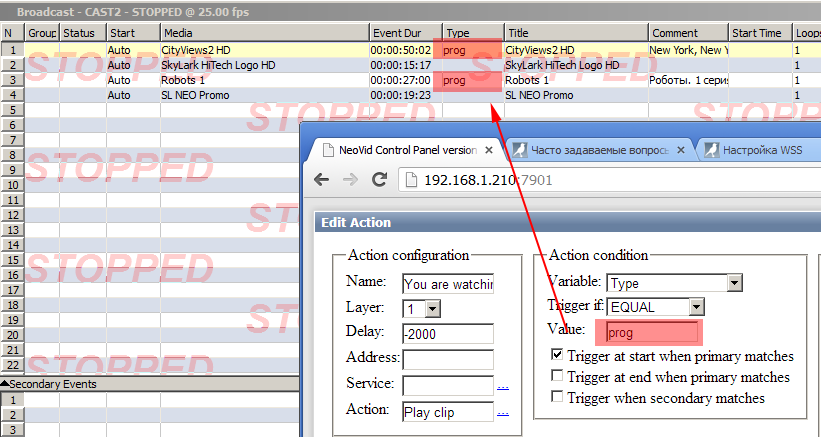Table of Contents
Titles "Now in Program"
Let's take a look at setting up automatic “now in program” title generation. We'll use the Skylark server's "Actions" automation rules engine for the job.
Create a title template
Let's create a graphic composition, which will be used as the title template.
The graphic composition consists of three elements:
- the BG animation substrate,
- text element “Text1” - (the inscription “Now in the program”), and
- text element “ProgTitle”, where the name of the current program will be substituted.
In the properties of the ProgTitle element, you need to set the parameterization type to “External”. Doing that, we will be able to set the text in the ProgTitle field during playback. Let's save the graphic composition and name it “You_are_watching_GR” for example.
When do I give out a title?
Now let's decide on which elements in the main playlist the “now in program” caption should be output on, and which should not.
Let's stipulate that we will only output a title on those playlist items that have “prog” in the “Type” column. This is the criterion by which we will distinguish “meaningful” broadcasts from commercials and interprograms.
For the example, we will take the text for the title from the “Comment” column. Note that when you put a clip into a playlist, the data from the media base fields automatically goes into the appropriate columns.
Setting Actions
We need to create a rule according to which the Skylark server will play the template graphic composition on certain lines of the main playlist, and the value of the “Comment” column of the current line of the main playlist will be passed to it.
Configuring the Actions program channel is performed from the server management console - Administrator Control Panel. The console is accessed either locally from the server, or from any client machine on the network at http://server_ip:7901. You must log in as an administrator.
After logging into the management console, select Manage in the left menu of the console. Then go to the “Program outputs” tab. In the window of the desired program channel select the “Actions” tab, and just below - “Playlist events”. Click the “Add action” link. The “Add action” rule creation window opens.
In the Action configuration section, specify the following settings:
- In the Name field, enter the name of the rule in any form.
- In the Layer field, select “1” - that means that the Action's condition will be tracked in the main playlist of the program channel.
- In the Delay field enter the value of the delay of the title issuing relative to the main playlist event. The delay value is specified in milliseconds and must have a negative value for a title after the beginning of the program and a positive value for a title before the beginning of the program. In this example, the title will appear 2 seconds after the program starts.
- In the Action field, click on the three dots next to the input field and select “Play clip”.
In the Action condition section you set the conditions of the rule triggering. Let's make the following settings:
- Select “Type” in the Variable field.
- In the Trigger if field we will set “EQUAL”.
- In the Value field let's type in “prog” (By this criterion we separate the programs, on which it is necessary to output the titer, from those, on which it is not necessary)
- You must check “Trigger at start when primary matches” and uncheck the other checkboxes.
In the Action parameters section, you need to set the settings for the “Play clip” action. Note that when you move the mouse pointer to the ParamN fields, the tooltips appear.
| Parameter | Description |
|---|---|
| Param1 | Specify the number of the graphic playlist in which the title will be played. |
| Param2 | You must enter the name of the template graphic song exactly as it is called in the media base. |
| Param4 | Set the In point of the graphic composition. The value is set in frames. In our case, the In point coincides with the beginning, so we set it to 0. |
| Param5 | Set the Out point. You have to recalculate the duration of the graphic composition in frames and put it in this field. |
| Param6 | Set Duration. You need to recalculate the duration of the graphic composition in frames and enter it in this field. You need to recalculate the duration of the graphic composition in frames. |
| Param10 | Set the parameterization of the graphic composition. Here you set the substitution of values from the main playlist columns into our graphic composition. Thanks to this, the title will “know” which show is on now. The Param10 field value should have the form element@value, where element is the name of the graphic composition element in which the substitution will be performed, and value is the substituted value. To fill the field, click on the three dots next to the entry field and select the name of the main playlist column that will contain the names of the programs from the drop-down list. In our case, this is the Comment column. After clicking OK, the value $(comment) will be inserted into the input field. Now add ProgTitle@ (“ProgTitle” is the name of the text element of our template graphic composition, the @ symbol is the separator in the name-value pair) before the value appears. Thus, the value of the Param10 field in our case should look like this: ProgTitle@$(comment). If you need to transmit more than one key-parameter value, they must be separated by the @ symbol. For example: param1@val1@param2@val2. |
| Param11 | we must write the action when the trigger is triggered - “PLAY” |
This completes the configuration. You have to click the OK button in the rule editing window and after that you have to click the “Apply changes” button at the top of the page. The corresponding program channel will be reloaded and the created automation rule will be applied and executed by the server during playlist playback.










